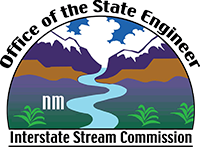Rio Grande Basin
The Rio Grande is the second longest river in North America, totaling more than 1,800 miles in length. It is second only in length to the Mississippi/Missouri River of the Central U.S. The Rio Grande headwaters begin in the southern Colorado Rockies and stretch south to the Gulf of Mexico. It is the predominant drainage feature in New Mexico.
The river enters the state north of the Rio Grande gorge and flows south through a series of alluvium-filled basins, or troughs, that have been produced by rifting processes over time. The subsequent erosion of the rift alluvium by the river and its tributaries has produced various landforms in and surrounding the basin. The Rio Grande rift through New Mexico has been in a process of development and deposition for millions of years.
Surface water flows originate primarily in the high mountain elevations as snow melt during the spring and as monsoonal rainfall during the late summer. Typically the river reaches its highest discharge between April and June, with its peak levels in May. Natural flows also show a great deal of variation from year to year due to drought and climate variability.
Several major drainages feed into the Rio Grande. Predominant surface water features that feed into the Rio Grande above the Otowi gage, in the Upper Rio Grande are the Red River, Rio Hondo, Pueblo de Taos, Santa Barbara, Embudo Creek, and the Rio Chama. South of Santa Fe, in the Middle Rio Grande, the only perennial tributary is the Rio Jemez, and in Lower Rio Grande, south to the New Mexico-Texas state line no perennial tributaries drain the Rio Grande.
The river flows through numerous villages, towns and cities of the state, including the city of Albuquerque. It is a major supplier of surface and ground water for residential, commercial and agricultural use in New Mexico.
In 1938, Colorado, New Mexico, and Texas signed the Rio Grande Compact apportioning the waters of the Rio Grande above Fort Quitman, Texas, among the three states. Therefore, the portion of the Rio Grande Basin of primary interest to the New Mexico Interstate Stream Commission begins at the headwaters of the Rio Grande in Colorado and extends some 450 miles south to Ft. Quitman, Texas.
